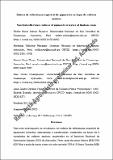Por favor, use este identificador para citar o enlazar a este item:
http://hdl.handle.net/10261/344651COMPARTIR / EXPORTAR:
 SHARE SHARE
 CORE
BASE CORE
BASE
|
|
| Visualizar otros formatos: MARC | Dublin Core | RDF | ORE | MODS | METS | DIDL | DATACITE | |

| Título: | Spectral-reflectance indices of pigments in leaves of Andean crops |
Autor: | Solano Reynoso, Walter Mario; Villantoy Palomino, Abraham; Soca Flores, Renato; Torres Huaripaucar, Noel; Dávalos, J.Z. CSIC ORCID | Palabras clave: | Anthocyanin Carotenoids Chenopodium quinoa Chlorophyll Solanum tuberosum Zea mays |
Fecha de publicación: | 1-ene-2023 | Editor: | Universidad Nacional de Colombia | Citación: | Acta Agronómica 72:1 (2023) | Resumen: | In this study, spectral reflectance indices of pigments (chlorophyll, anthocyanin, and carotenoids) contained in leaves of six varieties of Andean crops registered in the National Institute of Agrarian Innovation (INIA) of Ayacucho, Peru, were studied: white grain maize (MB) INIA 620, Wari and purple corn and cob INIA 615 Black Canaan (MM) (Zea mays), white potato tubers (PB) of the Yungay variety and red potato tubers (PR) INIA 316 Ayacuchana Red (Solanum tuberosum), and white grain quinoa (QB) of the Blanca de Junín variety and red grain (QR) INIA 620 Pasankalla (Chenopodium quinoa). These indices were determined from spectral reflectance data R(λ) between 350 and 2500 nm, obtained using the ASD FieldSpec 4 spectroradiometer between February 17th and March 9th, 2020, the time span was divided into three well-defined periods (initial, critical, and final). Direct measurements of reflectance R(λ) in the visible region showed a greater presence of anthocyanins in QR red quinoa than in the other crops. The four calculated chlorophyll indices (SR, NDCI, ChlRE, Chlgreen) had the same downward behavior for each crop studied, and any of them can be used to quantify the chlorophyll content. Red quinoa, unlike the others, showed an increasing trend in the last measurement. For the anthocyanin and carotenoid indices, they showed the same behavior in each crop, that is, a tendency to decrease or stabilize as in QB, QR and PR. In the case of the ratio index of carotenoids/chlorophyll (Car/Chl), the same trend did not occur in each crop, however, the CClHE index is the one that best accommodated to the six crops, as it showed more stationarity for all of them. Nevertheless, it is advisable to validate its use for each crop. Para esta investigación se estudiaron los índices de reflectancia espectralde pigmentos (clorofila, antocianina y carotenoides) contenidos en hojas de 6 variedades de cultivos andinosregistrados en el Instituto Nacional de Innovación Agraria (INIA) deAyacucho, Perú: maízde grano blanco (MB)INIA 620 Wari y maíz de grano y tusa de color moradoINIA 615 Negro Canaán(MM) (Zea mays);tubérculos de papacolor blanca (PB)de la variedad Yungay y tubérculos de papa de color roja (PR)INIA 316 Roja Ayacuchana (Solanum tuberosum);y quinuade grano blanco(QB)de la variedad Blanca de Junín y de grano rojo(QR)INIA 620 Pasankalla (Chenopodium quinoa). Los índices se determinaron a partir de datos de reflectancia espectralR(λ)entre 350 y 2500nm,obtenidos mediante el espectrorradiómetro ASD FieldSpec 4, entre el 17 de febrero yel9 de marzo de 2020, tiempo dividido en tres periodos bien definidos (inicial, crítico y final).Las medidas directas de reflectancia R(λ)en la región visible mostraron una mayor presencia de antocianinas en la quinua roja (QR)que en el resto de cultivos. Los 4 índices de clorofila calculados (SR, NDCI,ChlRE,Chlgreen) tienen el mismo comportamiento hacia el descenso para cada cultivo estudiado, por lo que puedeutilizarse cualquiera de ellos en la cuantificación del contenido de clorofila.La quinua roja, a diferencia de los otros, mostró una tendencia al incremento en la última medición. Para los índices de antocianinas y carotenoides los índices utilizados muestran también el mismo comportamiento en cada cultivo, es decir, tendencia a la disminución o estabilización,como en la QB, QR Y PR.En el caso del índice de la razón carotenoides/clorofila (Car/Chl) no se da la misma tendencia en cada cultivo; sin embargo, el índiceCClHEes el que mejor se acomoda en los 6 cultivos, por mostrar más estacionariedad para todos los cultivos.No obstante,es recomendable validar su uso para cada cultivo |
Descripción: | 26 pags., 6 figs., 1 tab. | Versión del editor: | https://doi.org/10.15446/acag.v72n1.106493 | URI: | http://hdl.handle.net/10261/344651 | DOI: | 10.15446/acag.v72n1.106493 | ISSN: | 0120-2812 | E-ISSN: | 2323-0118 |
| Aparece en las colecciones: | (IQF) Artículos |
Ficheros en este ítem:
| Fichero | Descripción | Tamaño | Formato | |
|---|---|---|---|---|
| 72_1_106493_ES_CC.pdf | Copia aceptada | 1,37 MB | Adobe PDF |  Visualizar/Abrir |
CORE Recommender
Page view(s)
24
checked on 16-may-2024
Download(s)
15
checked on 16-may-2024
Google ScholarTM
Check
Altmetric
Altmetric
Este item está licenciado bajo una Licencia Creative Commons

